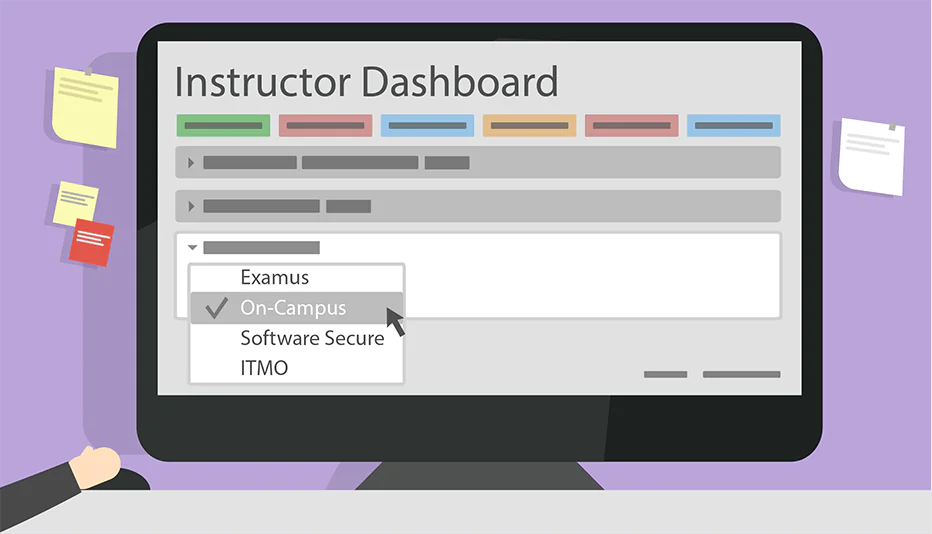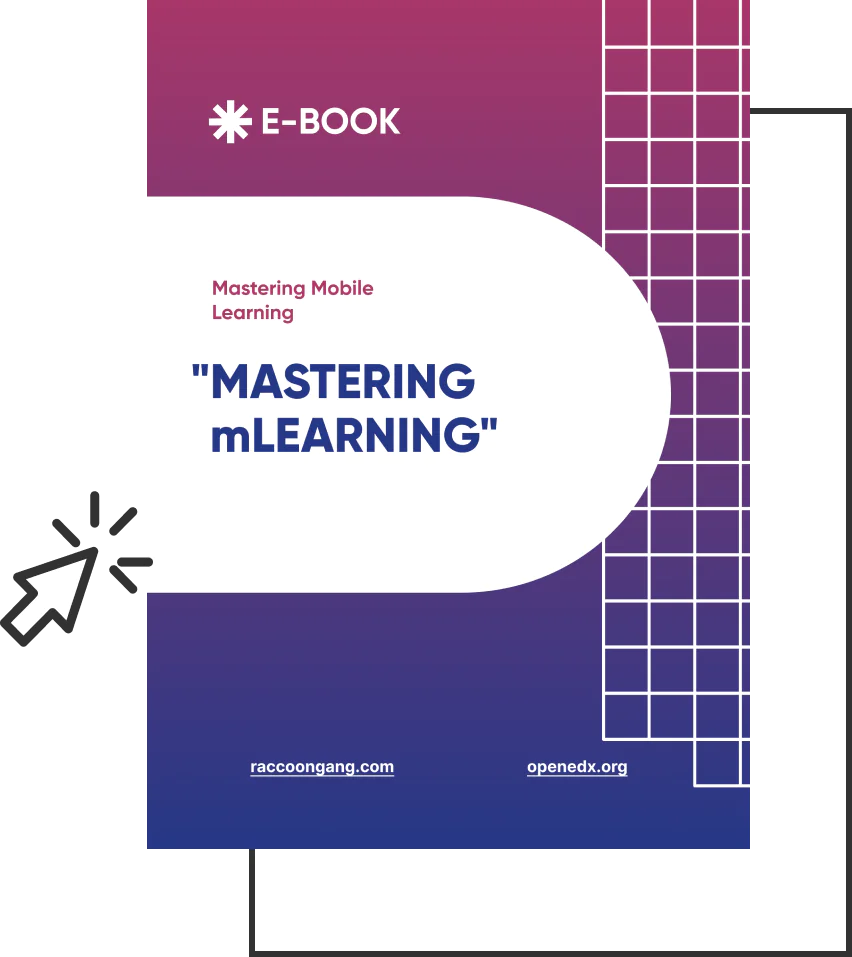Sophisticated eLearning platforms allow you to create a wide variety of training and educational materials for different industries. This means that the eLearning landscape includes a myriad of applications.
We, Raccoon Gang, have helped hundreds of customers develop their eLearning programs. Based on our experience, we can easily say that each program is unique. The modules are created and developed in accordance with the audience’s needs and the specific goals companies have.
To provide you with fresh ideas on how to engage your audience, we’ve compiled some effective eLearning modules you should consider including in your existing and upcoming eLearning applications.
What You Need to Know About eLearning Modules
eLearning modules are a central component of modern digital education. They are designed to be interactive, flexible, and accessible, providing learners with a structured format for their education. eLearning modules are usually self-contained units that focus on a specific topic or skill, which allows learners to progress at their own pace. These modules can include different kinds of educational content, such as text, images, videos, quizzes, simulations, games, and interactive activities. They also often feature progress tracking, feedback systems, and a variety of support resources to assist learners throughout their educational journey.
eLearning Modules Basics
eLearning modules are designed around a learning objective or set of objectives. Each module should clearly outline its aims, the knowledge and skills it intends to impart, and the way in which it will achieve these aims. To engage learners and promote understanding, modules should also incorporate a variety of teaching and learning methods.
These modules can be accessed through a variety of platforms, including Learning Management Systems (LMS), dedicated eLearning platforms, or through web browsers. They can be designed for different devices (desktop, laptop, tablet, mobile), and they are often designed to be used both offline and online, enabling learners to access them wherever they are, whenever they want.
The length of an eLearning module can vary greatly, depending on the topic and the depth of the content. It can range from a few minutes for microlearning modules to several hours for comprehensive courses.
More About eLearning Modules
One key advantage of eLearning modules is their adaptability to different learning styles. They can be designed with multimedia content to cater to auditory, visual, and kinesthetic learners. They can include interactivity, simulations, and real-world scenarios to provide hands-on experiences, or they can use storytelling, scenarios, and gamification to engage learners emotionally and cognitively.
Furthermore, eLearning modules enable personalized learning pathways. Learners can often choose the order in which they engage with the modules and the pace at which they progress, providing an individualized learning experience. Advanced eLearning modules may also use adaptive learning technologies to adjust the content and difficulty level based on the learner’s performance and needs.
Types of eLearning Modules
There are several types of eLearning modules, catering to a variety of educational needs. Here are a few examples:
- Microlearning Modules: These are bite-sized modules designed to convey a single concept or skill. They are typically short (5-10 minutes) and focused, making them ideal for busy learners who want to learn in short bursts.
- Comprehensive Course Modules: These are larger modules that cover a topic in depth. They are typically part of a larger course and may include several lessons or units within the module. They often come with assessments and certifications upon completion.
- Simulation Modules: These are interactive modules that provide learners with a simulated experience. They are especially useful for practical skills training, such as medical procedures, machinery operation, or crisis management.
- Game-Based Modules: These modules incorporate gamification elements to make the learning process more engaging and fun. They might include challenges, levels, points, badges, leaderboards, and other game mechanics.
- Adaptive Learning Modules: These are advanced modules that use artificial intelligence to adapt the content to the learner’s knowledge level, performance, and learning pace. They provide a highly personalized learning experience.
Here are the top eLearning modules:
Smooth Onboarding
First things first, have you planned something for new hires?
After all, they have a lot to take during the critical first few days on the job. If you require new employees to get up to equipment and tasks quickly, be sure to include an onboarding module.
You need a module that ensures a smooth onboarding process for the new employees. In this onboarding module, provide quick, focused overviews. Singly scrolling pages perform well to quickly train employees on key tasks. They should be able to refer back to the content whenever needed via their smartphones.
When creating the onboarding module, consider breaking down the practical tasks into simple steps. Adding checklists for steps or other components should provide further support to learners, while video demonstrations can be included to make it more engaging. Don’t forget to add in-page navigation as it helps learners know what’s coming next, greatly increasing their chances of completing the course quickly.
Gamified Scenario
Gamified modules have proved to be one of the most effective ways to engage learners with eLearning content. eLearning platforms with gamification functionality are in high demand among educators and learners alike.
According to a University of Colorado research, learners that use gamified eLearning platforms score higher in skills and fact-based assessments. It also reported improved employee retention in organizations leveraging gamification in eLearning programs.
The module uses gaming elements, such as scores, leveling, and leaderboards to motivate the learners and train them at the same time.
By creating an environment of competition, gamified scenarios allow learners to compete against each other, their own performances, or the game. It adopts a game-based problem-solving approach rather than pushing learners straight into data and facts. Most gamified modules include a story and embed the user in the plot.
An avatar is a great example of a gamified module in which employees are placed in the game. This type of gamification is used when each employee needs to receive new training at different stages. The perfect application of this module is call centers or customer service departments in firms. The approach can help the representatives learn about the company, its offerings, and other aspects from scratch.
If your business involves hazardous situations, AR and VR are a safe way to train employees. You won’t need to put your employees in danger with on-the-job training. For example, pilots can be trained using flight simulators before they start leading real flights. In the early stages of the training, learners should be required to respond to emergencies or make decisions. Then, simulations should be implemented to train employees in engineering, retail, and other fields.
If you wish to train your employees on a specific process, your gamification module can be a task-oriented approach. Depending on the nature of your business, the process can be simple or complex. The approach can be used to develop a full-fledged resource management system or simply train plumbers for a new skill. Learners are assigned a task and provided with options and tools to complete it. In case the user fails to complete a task, they need to go back to the beginning. When they succeed, they should move on to the next task.
You may also incorporate gamification into assessments, creating a low-pressure setting for employees. This works really well if you need a quick snapshot of the skills possessed by your employees. You may even be able to design applications in a way that employees won’t even know that they are being assessed.
However, don’t use this strategy to penalize employees. Use the insights to clarify misunderstandings or to structure and design future training.
Question Pools
Testing is a critical part of eLearning, especially in the areas of compliance. The assessment module in your eLearning program should be able to test the learners thoroughly enough. One great strategy is to use question pools.
These can be used to set up a solid assessment, especially for a compliance test. Learners aren’t likely to see the same set of questions when they retake the test. This ensures that they actually learn and understand the content instead of just choosing a different answer for the same question upon the next attempt.
Also, employees won’t be able to share questions or answers with their colleagues or other learners as everyone will answer a different set of questions.
Branching
This module puts learners in the driving seat, which proves incredibly useful in improving their engagement with the digital learning experience. This involves using ‘choose your own adventure’ style scenarios that enable learners to make decisions that control the outcome of the story they’ve been put into. Learning is based on experiencing consequences rather than just being informed of them.
To maximize the impact of branching, consider using video-based eLearning. This might include powerful video scenarios with multiple decision points as well as the ability to see the impact of the decisions learners make. Text and audio-based scenarios can also be highly effective.
If your employees respond well to active, experiential participation, branching should be a great learning approach. But make sure your content includes real-life decisions and their impact.
‘On-the-Job’ eLearning Module
Learning shouldn’t have to be separated from the actual job. If your employees have a lot to remember, such as the product features, an ‘on-the-job’ module can be of great help. This involves providing short, snappy resources to be used during the work. Employees won’t even have to leave work to benefit from this module.
According to experts, eLearning will go beyond LMS courses and become integrated into learners’ work processes. Clark Quinn, the director at Quinnovation and a cognitive science and learning technology expert, says that contextualized learning should replace knowledge tests and information dump. That’s the reason the on-the-job training module makes our list of the top eLearning modules for 2020. For that, L&D should not only be ahead of performance support but also be able to leverage social and informal learning.
In addition, the head of InfoMedia Designs, Steve Foreman, believes that L&D should stop relying on static courses on LMS and incorporate meaningful learning in practice. According to him, training in the future will be more performance-oriented than just developing knowledge and skills among employees. With that approach, ‘on-the-job’ eLearning modules will become common.
Hence, L&D departments have already started focusing on providing support to human performance by incorporating learning in the flow of work, professional development solutions, and talent management.
Since an ‘on-the-job’ eLearning module is succinct and useful, it can be more popular among learners too. An ideal application for this module could be a quick digital resource to provide just-in-time support to salespeople dealing with shoppers in the store.
Oftentimes, there’s a lot of theoretical content that needs to be made practical but other eLearning tactics won’t work. This can involve content related to change management and new procedures. ‘On-the-job’ module is a perfect solution for this. Apart from products or systems training, factual content that learners might need to be reminded of can be delivered through this module.
Best eLearning tools to Design Training Courses
Now that you’re aware of the top eLearning modules, it’s time to design them. Here are some of the best eLearning tools to create online courses:
Docebo
Docebo is an LMS that uses artificial intelligence (AI) technology to help you create personalized courses and automate time-consuming administrative tasks. It comes with a 700-course library that you can use to create and centralize learning content, manage learning activities, and incorporate social learning in the flow of work. Its AI Virtual Coach allows for effective learning, while its insightful report generation enables real-time performance tracking.
Raptivity
This amazing eLearning solution allows you to build visually stimulating learning interactions. It features around 190 built-in responsive and customizable interactions. You can create different interactive models, including software simulations, brainteasers, flashcards, diagrams, surveys, wild cards, and more. Not only does it support microlearning via integrations with eLearning authoring tools but also features AI-powered media search.
ProProfs Training Maker
If you have limited time, this should be the best option for you. The ProProfs Training Maker comes with a massive pool of pre-built courses and templates, allowing you to use existing material or develop content from scratch within minutes. You may add presentations, videos, quizzes, documents, surveys, and more to make them more engaging.
It’s a highly scalable LMS software, allowing you to adapt your activities and courses according to your training needs. Its analytics features and real-time reports are quite valuable for tracking course performance and engagement.
Moreover, the solution supports seamless third-party integrations, course monetization, knowledge-sharing and, branding, and customization.
Whatfix
This is a Software-as-a-Service (SaaS) employee training platform that allows you to create engaging courses for the digital adoption of your enterprise applications. It should help your employees quickly familiarize themselves with the apps or software products you use.
Through Whatfix, you can empower your employees by providing them with customized contextual help and personalized learning paths. Apart from helping you create eLearning modules, you can even use employee roles to organize the content. The solution can be seamlessly integrated with your LMS or other tools.
Hoopla
Hoopla is a metric-based employee engagement and motivation platform optimized for mobile phones. Through this platform, you can engage learners using friendly competition and gamification scenarios, while also monitoring their performances in real-time.
Not only can you create interactive courses with this tool but also integrate it with other eLearning authoring tools to add more features to the courses.
To accomplish your training goals while keeping the employees motivated, you can set multiple Hoopla Channels and broadcast personalized newsflashes across the organization.
Zunos
Zunos is similar to Hoopla in that it places particular emphasis on gamification, yet, it’s different in many ways. Apart from gamification, it lets you build and curate interactive eLearning content and add personalization and communication to improve engagement.
You can create on-demand content, micro-learning sessions, and instructor-led training courses. Zunos is a highly versatile platform that can be used to design eLearning courses for a wide variety of applications, including onboarding, product or service training, marketing, HR, sales, L&D, and any other operation that requires training for multiple tasks.
Final Word
Training is a significant part of employee growth and business success, which is why L&D places particular emphasis on it. The most talented professionals choose to work for organizations that offer ongoing learning and development opportunities to staff. As a result, businesses have started looking into the latest eLearning modules to develop engaging training solutions for their employees.
After exploring the top eLearning modules discussed above, you shouldn’t waste any more time and go ahead with their implementation. Raccoon Gang can create a solution that incorporates all the trending modules necessary for your individual case. Click here to obtain a quote.
-
2757 31/Oct/2016
-
1974 25/Sep/2020





